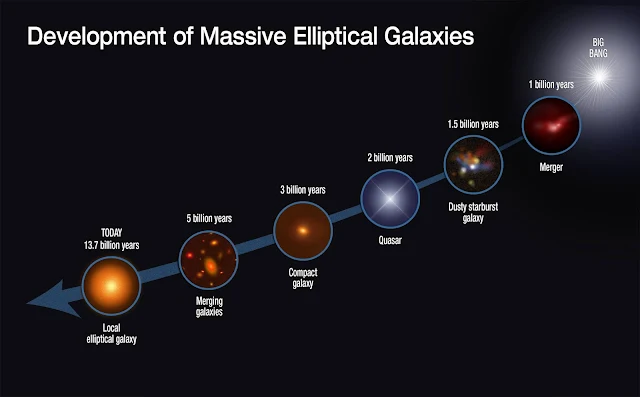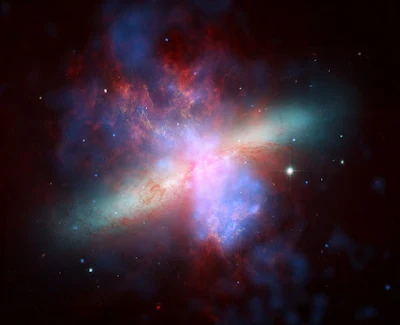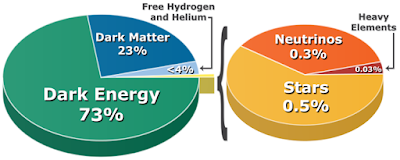A Galaxy is a huge collection of dust, gas, and billions of stars and their solar system. A galaxy is held together by gravity. Our Galaxy, the Milky way also has a Supermassive black hole in the middle. Sometimes galaxies get too close and smash into each other. Our Milky way galaxy will someday bump into Andromeda, our closest galactic neighbour.
But not to worry.....It won’t happen for about five billion years. Even if it happened tomorrow we might not notice.
Galaxies are so big and spread out at the ends that even though galaxies bump into each, the planets and solar systems often don’t get close to colliding.
The word Galaxy is derived from the GREEK galaxies literally “MILKY’’ a reference to the Milky way. Galaxies range in size from dwarfs with just a few hundred million stars [108] to giants with one hundred million [1014] stars each orbiting its galaxy's center of mass.
Why is it important to understand Galaxy?
Galaxies show us how the matter in the universe is organized in large scales and scientists study how the matter is currently organized and has changed throughout cosmic time.
The galaxies were more numerous, but smaller, bluer and clumpier, in the distant past than they are today and that galaxy mergers play a significant role in their evolution. At same time, quasars and galaxies that emitted their light when the universe was less than a billion years old so we know that large condensations of matter had begun to form at least that early. Many quasars are found in centers of elliptical galaxies. This means that some of the first large concentrations of matter must have evolved into the elliptical galaxies that we see in today’s universe. It seems likely that the supermassive black hole in the center of galaxies and the spherical distribution of ordinary matter around formed at the same time and through related physical processes.
Dramatic confirmation of that picture arrived only in the last decade, when astronomers discovered a curious empirical relationship: as we saw in Active Galaxies, Quasars, and Supermassive Black Holes; the more massive a galaxy is, the more massive its central black hole is. Somehow, the black hole and the galaxy “know” enough about each other to match their growth rates.
Since Galaxies are observed over cosmological length and time scales, the description of their formation and evolution must involve cosmology. The study of properties of space and time on large scales. Modern cosmology is based upon the cosmological principle, the hypothesis that the universe is especially homogeneous and isotropic.
Types of galaxies are included Spiral galaxies, Elliptical galaxies, Irregular galaxies. This shape classification of galaxies was created by Edwin Hubble in 1926.
Spiral Galaxies: These are the most common type of galaxy in the universe. Of all known galaxies in the universe, 77% of them are classified as spiral galaxies.
Elliptical Galaxies: These are classified by their ovular shape and lack of central bulge.

Irregular Galaxies: Each irregular galaxy doesn’t have a size or shape that is what we known as irregular. These don’t have any previously discussed components.
The Milkyway is the galaxy that contain our solar system, with the name describing the galaxy’s appearance from earth. A hazy band of light seen in the night sky formed from stars that cannot be individually distinguished by the naked eye. From earth, the Mlikyway appears as a band because its disk shaped structure is viewed from within. Galileo Galilei first resolved the band of light into individual stars with his telescope in 1610. Until the early 1920s most astronomer thought that the Milkyway contained all the stars in the universe. In 1920, great debate between the astronomer Harlow Shapley and Heber Curtis, observations by Edwin Hubble showed that the Milkyway is just one of many galaxies.
The Milkyway is a barred Spiral galaxy with an estimated visible diameter of 150-200,000 light years, an increase from traditional estimates of 100,000 light years. It is estimated to contain 100-400 billion stars and at least that number of planets. The solar system is located at a radius of about 27000 light years from the galactic center, on the inner edge of the Orion Arm, one of the spiral-shaped concentrations of gas and dust.
It is the second largest galaxy in the local group (after the Andromeda galaxy), with its stellar disk approximately 170,000-200,000 light years in diameter and on average approximately 1000 light year thick. The Milkyway is approximately 890 billion to 1.54 trillion times the mass of the sun.

Star Formation in Galaxies:
Stars are heavily bodies, which shine like our sun. Many shines brightly, the others have a dim glow. Some are red while others are blue, stars are giant balls of gas made of hydrogen, bound together by their own force of gravity. The energy that makes them shine comes from a kind of power plant in their interior, where atomic nuclei of hydrogen atoms are fused together to form helium atoms. The stars don’t live forever and die at some point. Many simply get extinguished, while very heavy stars expand and explode. Their remains become either a neutron star or a blackhole.
How is a Star born?
The cradle of a star is a cloud of hydrogen and dust. There are numerous such clouds in the universe. By the action of external force –such as explosion of a star this cloud gets compressed and keeps pulling itself together due to increasing force of attraction among the particles. After a few hundreds of thousands of years, it begins to shine. A proto-star, a star in the early stages, is formed. This keeps pulling itself together while rotating, and becomes hotter and hotter, till its interior reaches a temperature of around 10-million-degree Celsius. In the core of the star, the fusion of hydrogen into helium releases an enormous amount of energy. Now, the star becomes a main sequence star. It shines approximately for 10 billion years, till it dies.
A proto- star arises from a cloud. The shining main sequence star explodes in a Supernova. Its mass collects together to form a neutron star or a blackhole.
Why do all stars not shine with the same intensity?
How do stars die?
There are two reasons why all the stars in the night sky don’t shine equally brightly. Firstly, the stars are at different distances from the earth, secondly, the luminosity. Young stars are bright, hot and shine bluish- white, and older stars which have already given out a lot of their energy are red in colour. Our sun is middle aged (about 4.8billion years old) with a temperature of around 5778K on its surface, and shines with a bright yellowish-white color. Stars are like a window to the past. If a star is 10 light years away, we are observing 10 years back star.
How do stars die?
When the fusion of hydrogen into helium takes place in the core of the star, it continues to shine for about 10 billion years.
At some point of time, however, all the hydrogen gets consumed. Helium then melts to form carbon. What happens after this, depends on the mass of the star. Lighter stars like the sun expand to become a red giant, till the fusion stops, and then implode to become a white mass about the size of the earth. Very large stars, about 20 times heavier than our sun, expand to become a giant and finally explode. This is known as ‘Supernova’. The remains of supernova become either a neutron star or a blackhole.
Dark Matter:
Dark matter is a form of matter throughout to account for approximately 85% of the matter in the universe and about a quarter of its total mass energy density or about 2.241x10^-27 kg/m^3.
Its presence is implied in a variety of astrophysical observations, including gravitational effects that cannot be explained by accepted theories of gravity unless more matter is present that can be seen. For this reason, most experts think that dark matter is abundant in the universe and that it has had a strong influence on its structure and evolution. Dark matter is called dark because it doesn’t appear to interact with the electromagnetic radiation, and is therefore difficult to detect.
The hypothesis of dark matter has an elaborate history. In a talk given in 1884, lord Kelvin estimated the number of dark bodies in the milkyway from the observed velocity dispersion of stars orbiting around the center of the galaxy. Lord Kelvin thus concluded “many of our stars” perhaps a great majority of them, may be dark bodies.
Dark matter contributes 85% of total mass, while dark energy plus dark matter contributes 95% of total mass energy content. Because dark matter has not yet been observed directly, if it exists, it must barely interact with ordinary baryonic matter and radiation, except through gravity. Most dark matter is thought to be non-baryonic in nature. It may be composed of some as yet undiscovered subatomic particles. Dark matter is classified as “cold” “warm” or “hot” according to its velocity.
Black hole is a place in space where gravity pulls so much that even light cannot get out. The gravity is so strong because matter has been squeezes into a tiny space. This can happen when a star is dying.
No light can get out of a black hole and all light is absorbed by it, so black holes cannot be seen but can be detected by its surroundings variations.
Black holes can be big or small scientists think the smallest black hole are as small as just one atom. These black holes are very tiny but have the mass of a large mountain.
Black holes are the concept which cannot be understood completely and in maximum cases the assumptions were made.
The largest black holes are called Supermassive. These blackholes have masses that are more than 1 million suns together. The supermassive blackhole at the center of the milky-way galaxy is called Sagittarius. It has a mass equal to about 4 million suns and would fit inside a large ball that would hold a few million earths.
How do black hole form?
Scientists think the smallest black holes formed when the universe began. Stellar black holes are made when the centers of a very big star falls in up to itself or collapses. When this happen, it causes a supernova is an exploding star, that blasts part of the star into space.
If you jump into the black hole feet first, the gravitational force on your toes would be much stronger than that on your head and you will be elongated in a slightly different direction. you could literally end up looking like a Spaghetti.
The study of galaxy formation is never ending and there is much more to know as we move on. However, linking observations to theory is significantly impeded by many uncertainties both observational and theoretical.
Currently most observational studies are based on mass limited galaxies, since stellar mass is relatively easy to measure well with many of its properties.
Finding a reliable way to trace real galaxies growth over a large mass range is one of the key challenges still facing this field.
Submitted by:
· KAVYASHREE
· KRITHI C H
· MARIYA ROSE
· NALINI M
· PALLAVI BEKAL
REFERENCES:
INTERNET
JOURNAL
ENCYCLOPEDIA















































